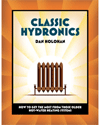
With the expansion of technology in the boiler industry over the last 10 years, the number of options available to the engineer has increased dramatically. Engineering a new system or even a replacement boiler can be confusing when sorting through all of the equipment options available and matching them to the project design criteria.
Some of the selection criteria are easily identified, including fuel, load, and the application-water or steam. Proper selection must also take into account efficiency, venting, and system design. These three selection factors are not independent, but are interconnected and must be considered in the selection process.
Since the majority of applications for boilers are gas-fired water boilers, this article will primarily focus on this area. Some of the ideas highlighted could apply to steam or oil-fired boilers.
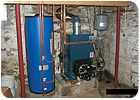
The
Dunkirk Empire II Series boiler. All photos courtesy of ECR International.
System Design
As a starting point in the selection process, a heating load calculation on the structure should be completed using a Manual J or equivalent format, and if possible, completed on a room-by-room basis. For an existing boiler replacement, a survey of the connected load in each room, which could include cast iron radiation, fin-tube baseboard, convectors, radiant tubing or panels, should be completed. A comparison of the connected load in each room with the Manual J heat loss will ensure that the system is designed to properly heat the structure.If a difference is identified between the connected load and the calculated heat loss for that room, a correction should be made either adding or removing radiation as needed. Correcting the radiation will eliminate hot and cold areas, increasing the comfort of the occupants.
Additional loads beyond space heating should be considered. Indirect water heaters for domestic water heating, snowmelt systems and pool heating all can influence the selection of the boiler. Often these additional loads, particularly in new construction, can require a larger load than the load for heating the structure.
Accounting for these additional loads in the boiler sizing depends on the type of control system envisioned. The selection of the control system could allow the engineer to select a boiler to satisfy only the largest of the loads-not the total of all loads in the system. For example, if you select a priority control system for managing either the indirect water heater or the heating zones, the boiler could be sized for only the larger of the two loads: space heating or domestic water heating. This design strategy can be selected, as the priority control will allow only one of the loads to operate at any given time.
When selecting the boiler, using several smaller boilers instead of one larger unit can prove to be beneficial. During the off-peak months, when the demand loads are much less, the number of boilers operating can be reduced to better match the heat loss of the structure. Overall, this improves system efficiency and increases the service life of the equipment as short-cycling is reduced.
Furthermore, the additional boilers provide a heating redundancy, as a single component failure is unlikely to shutdown the entire system. Should any of the boilers need to be serviced during a breakdown, the remaining boilers may be able to provide adequate heating during this period.
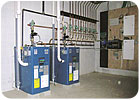
The
Dunkirk Q90-200 Series boiler.
Boiler Location
With the load for the boiler established, review the planned location of the boiler, considering more than the physical footprint available for the boiler. Survey the installation-looking at the availability and sources of combustion air, the dimensions of the boiler room, method for venting, the construction of the floor, clearances to combustibles and accessibility for maintenance.The results of your survey are going to help direct you towards the correct boiler(s) for your applications. Venting and availability of combustion air need to be addressed first, as answering the following questions will narrow the field of available boilers. (Remember, if the boiler room volume is less than 50 cubic feet per 1,000 Btuh of the total input rating of all appliances installed in the space, then the installation is confined and additional sources of air for combustion, ventilation and dilution of the flue gases will be needed.)
If your answer to any of these questions is “no,” then your selection should focus on fan-assisted Category I boilers. If you answer no to the last two questions, then a Category III or IV sealed combustion or direct vent boiler may be your best fit. Generally, Category III and Category IV boilers operate at higher efficiencies, so upgrading to these appliances has two positive effects: first, solving your venting and ventilation requirements; and second, providing the end user with years of fuel savings.
If the chimney and combustion air sources are not of concern, then atmospheric vented boilers are still available options. Review the arrangement of the boiler room again.
Determine from the layout of the boiler room if maintenance access is available in the front, and on one or both sides of the boiler. Consider where the best arrangement for piping connections on the boiler would be.
Atmospheric boilers generally have lower efficiencies, resulting in a larger and potentially heavier boiler required. The location of the controls and piping connections varies by manufacturer, offering the engineer numerous options. Determining the best location for controls, piping and venting in the design state will help to identify which boiler(s) will best fit your application.
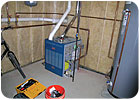
The
Utica USC Series boiler.
Efficiency
If the physical requirements of the boiler location have not dictated that a Category III or Category IV appliance is best, you should still consider an upgrade to a higher efficiency boiler. Over the last 10 years, a new class of high-efficiency condensing boilers with AFUE efficiencies of 90% and greater have entered the market. These new products are focusing on the main boiler application of water heating with natural or propane gas, with a smaller number of models available firing oil.Evaluating high efficiency should include more factors than the initial cost of the boiler vs. the fuel savings. A decision should be made on the total installed and operating cost in the installation using a variety of manufacturers’ products. Consider these factors:

The
Utica DV Series boiler.
What savings for chimney liners or stainless steel venting are available by upgrading to a higher efficiency boiler?
What special installation requirements, such as high-head circulator pumps or primary-secondary piping, will add to the installation costs?
Operating Factors
Evaluate the total operating energy costs for an installation. High-efficiency boilers will save on natural gas or propane usage, but the added electrical requirements for high-head circulator pumps, if required, will reduce the annual savings for the end user. The requirements for circulators and piping vary greatly by manufacturer.
Does the high-efficiency boiler qualify for federal, state or utility incentives? Currently, a tax credit may be earned in a qualified residential application for boilers 95% AFUE and above. Many states and utilities offer incentives for boilers meeting the Energy Star guidelines. These financial incentives reduce the initial installation cost, improving the consumer’s return on investment.
Controls
Review the controls that are included on the condensing boilers. Several manufacturers include outdoor temperature reset controls, which automatically reduce the boiler system water temperature as the outdoor temperature rises. Other models include low water cutoff controls with their condensing boilers, potentially eliminating the need for these controls to be added externally if required by local codes.
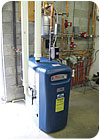
The
Utica UB95M-200 Series boiler.
Review the manufacturer’s requirements for servicing the boiler and maintaining the warranty. Several manufacturers offer extended parts and labor warranties for residential installations, reducing any out-of-pocket costs for repairs above normal maintenance.
Condensing boilers may require annual inspection and cleaning of the heat exchanger to maintain the warranty. Increasing the annual servicing costs with these inspections negates some of the savings in energy consumption the higher-efficiency boiler provides. The net result to the consumer is a reduced return on investment for purchasing the high-efficiency boiler.
Compare the cost and availability of service parts between the different condensing boiler manufacturers. Selecting a 90% efficient boiler with simple low-cost controls may be of a greater benefit to the end consumer than offering a 93% AFUE with a more sophisticated and costly control system.
If a condensing boiler is selected, consideration must be given to the expertise needed to properly install, service and maintain the boiler. Matching the level of technology to the consumer’s capabilities usually results in the best applications.
Using the systematic approach outlined above when selecting a boiler will help expedite the engineering process and result in installations that provide the best combination of technology, installation and operating costs.




